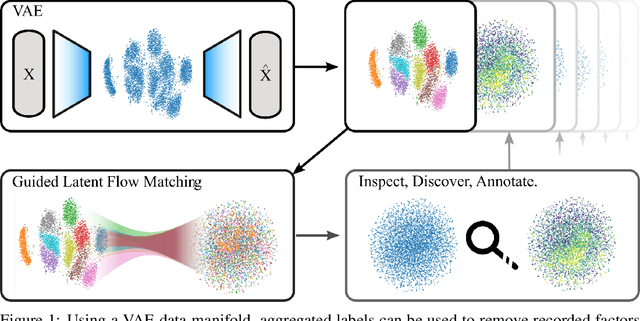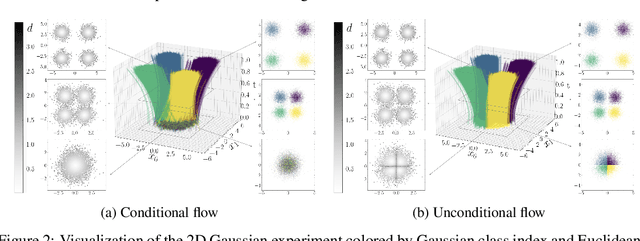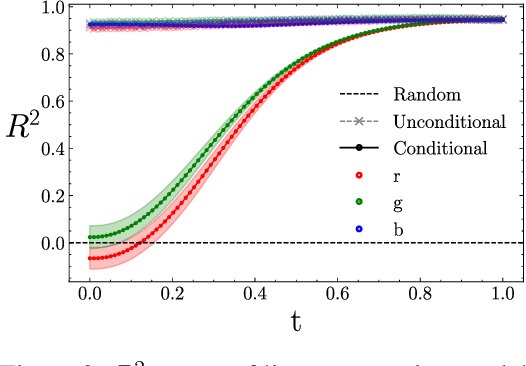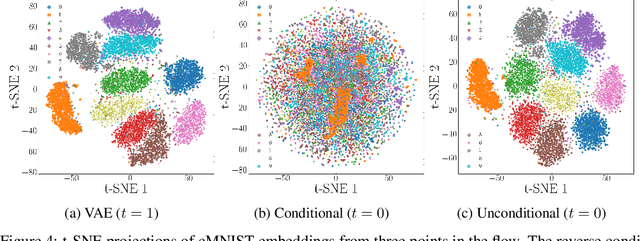Steve Croft
What We Don't C: Representations for scientific discovery beyond VAEs
Nov 12, 2025



Abstract:Accessing information in learned representations is critical for scientific discovery in high-dimensional domains. We introduce a novel method based on latent flow matching with classifier-free guidance that disentangles latent subspaces by explicitly separating information included in conditioning from information that remains in the residual representation. Across three experiments -- a synthetic 2D Gaussian toy problem, colored MNIST, and the Galaxy10 astronomy dataset -- we show that our method enables access to meaningful features of high dimensional data. Our results highlight a simple yet powerful mechanism for analyzing, controlling, and repurposing latent representations, providing a pathway toward using generative models for scientific exploration of what we don't capture, consider, or catalog.
Anomaly Detection and RFI Classification with Unsupervised Learning in Narrowband Radio Technosignature Searches
Nov 25, 2024



Abstract:The search for radio technosignatures is an anomaly detection problem: candidate signals represent needles of interest in the proverbial haystack of radio-frequency interference (RFI). Current search frameworks find an enormity of false-positive signals, especially in large surveys, requiring manual follow-up to a sometimes prohibitive degree. Unsupervised learning provides an algorithmic way to winnow the most anomalous signals from the chaff, as well as group together RFI signals that bear morphological similarities. We present GLOBULAR (Grouping Low-frequency Observations By Unsupervised Learning After Reduction) clustering, a signal processing method that uses HDBSCAN to reduce the false-positive rate and isolate outlier signals for further analysis. When combined with a standard narrowband signal detection and spatial filtering pipeline, such as turboSETI, GLOBULAR clustering offers significant improvements in the false-positive rate over the standard pipeline alone, suggesting dramatic potential for the amelioration of manual follow-up requirements for future large surveys. By removing RFI signals in regions of high spectral occupancy, GLOBULAR clustering may also enable the detection of signals missed by the standard pipeline. We benchmark our method against the Choza et al. (2024) turboSETI-only search of 97 nearby galaxies at L-band, demonstrating a false-positive hit reduction rate of 93.1% and a false-positive event reduction rate of 99.3%.
The weird and the wonderful in our Solar System: Searching for serendipity in the Legacy Survey of Space and Time
Jan 16, 2024Abstract:We present a novel method for anomaly detection in Solar System object data, in preparation for the Legacy Survey of Space and Time. We train a deep autoencoder for anomaly detection and use the learned latent space to search for other interesting objects. We demonstrate the efficacy of the autoencoder approach by finding interesting examples, such as interstellar objects, and show that using the autoencoder, further examples of interesting classes can be found. We also investigate the limits of classic unsupervised approaches to anomaly detection through the generation of synthetic anomalies and evaluate the feasibility of using a supervised learning approach. Future work should consider expanding the feature space to increase the variety of anomalies that can be uncovered during the survey using an autoencoder.
A Deep Neural Network Based Reverse Radio Spectrogram Search Algorithm
Feb 24, 2023



Abstract:We developed a fast and modular deep learning algorithm to search for lookalike signals of interest in radio spectrogram data. First, we trained an autoencoder on filtered data returned by an energy detection algorithm. We then adapted a positional embedding layer from classical Transformer architecture to a frequency-based embedding. Next we used the encoder component of the autoencoder to extract features from small (~ 715,Hz with a resolution of 2.79Hz per frequency bin) windows in the radio spectrogram. We used our algorithm to conduct a search for a given query (encoded signal of interest) on a set of signals (encoded features of searched items) to produce the top candidates with similar features. We successfully demonstrate that the algorithm retrieves signals with similar appearance, given only the original radio spectrogram data.
A deep-learning search for technosignatures of 820 nearby stars
Jan 30, 2023Abstract:The goal of the Search for Extraterrestrial Intelligence (SETI) is to quantify the prevalence of technological life beyond Earth via their "technosignatures". One theorized technosignature is narrowband Doppler drifting radio signals. The principal challenge in conducting SETI in the radio domain is developing a generalized technique to reject human radio frequency interference (RFI). Here, we present the most comprehensive deep-learning based technosignature search to date, returning 8 promising ETI signals of interest for re-observation as part of the Breakthrough Listen initiative. The search comprises 820 unique targets observed with the Robert C. Byrd Green Bank Telescope, totaling over 480, hr of on-sky data. We implement a novel beta-Convolutional Variational Autoencoder to identify technosignature candidates in a semi-unsupervised manner while keeping the false positive rate manageably low. This new approach presents itself as a leading solution in accelerating SETI and other transient research into the age of data-driven astronomy.
 Add to Chrome
Add to Chrome Add to Firefox
Add to Firefox Add to Edge
Add to Edge